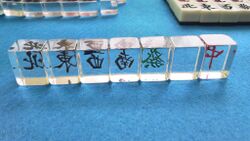Washizu mahjong: Difference between revisions
No edit summary |
|||
| Line 1: | Line 1: | ||
[[Image:Washizutiles.jpg|thumb|250px|Transparent Jihai in Washizu Mahjong]]'''Washizu Mahjong''' is a | [[Image:Washizutiles.jpg|thumb|250px|Transparent Jihai in Washizu Mahjong]]'''Washizu Mahjong''' is a variant of [[Japanese mahjong]] that originates from the 1991 manga series [[Akagi]]. The rules are mostly the same, except that three tiles of every tile type are transparent. As a consequence, players are able to see most of the other players' hands, which alters gameplay greatly. | ||
== Tiles == | == Tiles == | ||
Of the tiles, three out of four of each type are transparent. | Of the tiles, three out of four of each type are transparent. They can be made out of clear plastic, acrylic, or even glass. | ||
If you do not have transparent tiles, the following can be used instead: | |||
*Have two different mahjong sets with different color tile backs. Pick three tiles of one set and one tile of the other. Whenever someone draws a tile of the more common color, they must reveal it and keep it face up. | |||
*Mark the backs of 3/4 tiles of a regular mahjong set to show what tile it is. | |||
The game | == Other rule differences == | ||
The main rules to the game is retained. Rules dictating [[yaku]], [[furiten]], completed hands, and any selected [[rule variations]] still apply. The game processes are altered to fit the transparent tiles. | |||
In computer game interfaces, | *No [[yama|walls]] are built. Instead, when picking tiles from the live/dead wall, tiles are shuffled and drawn from a non-transparent bag. In order to prevent players from feeling tiles, players wear gloves. Similarly, to reveal dora indicators, a tile is drawn from the bag. | ||
*Players are not required to arrange the tiles in any particular way. This allows players to mask the use of opaque tiles to hint some tile disinformation. | |||
In computer game interfaces, these are non-factors. In the case of [[Majsoul]], the game does not display the walls. Also, the game masks how the tiles are arranged when other players view them. This makes [[List_of_special_rooms_in_Mahjong_Soul#Battle_of_Clairvoyance|implementation]] of Washizu mahjong possible to play "normally". | |||
==Strategy== | ==Strategy== | ||
Game strategy is altered from the additional information of tiles in player hands. | Game strategy is altered from the additional information of tiles in player hands. This increases a player's ability to [[kabe|count tiles]] and assess tile availability. Likewise, it's usually much easier to [[defense|defend]] when you know what the player's hand structure is. Conversely, it is a lot harder to win by ron. | ||
==External links== | ==External links== | ||
Revision as of 20:24, 6 April 2024

Washizu Mahjong is a variant of Japanese mahjong that originates from the 1991 manga series Akagi. The rules are mostly the same, except that three tiles of every tile type are transparent. As a consequence, players are able to see most of the other players' hands, which alters gameplay greatly.
Tiles
Of the tiles, three out of four of each type are transparent. They can be made out of clear plastic, acrylic, or even glass.
If you do not have transparent tiles, the following can be used instead:
- Have two different mahjong sets with different color tile backs. Pick three tiles of one set and one tile of the other. Whenever someone draws a tile of the more common color, they must reveal it and keep it face up.
- Mark the backs of 3/4 tiles of a regular mahjong set to show what tile it is.
Other rule differences
The main rules to the game is retained. Rules dictating yaku, furiten, completed hands, and any selected rule variations still apply. The game processes are altered to fit the transparent tiles.
- No walls are built. Instead, when picking tiles from the live/dead wall, tiles are shuffled and drawn from a non-transparent bag. In order to prevent players from feeling tiles, players wear gloves. Similarly, to reveal dora indicators, a tile is drawn from the bag.
- Players are not required to arrange the tiles in any particular way. This allows players to mask the use of opaque tiles to hint some tile disinformation.
In computer game interfaces, these are non-factors. In the case of Majsoul, the game does not display the walls. Also, the game masks how the tiles are arranged when other players view them. This makes implementation of Washizu mahjong possible to play "normally".
Strategy
Game strategy is altered from the additional information of tiles in player hands. This increases a player's ability to count tiles and assess tile availability. Likewise, it's usually much easier to defend when you know what the player's hand structure is. Conversely, it is a lot harder to win by ron.
External links
- Washizu (YouTube)
- A demonstration how Washizu Mahjong will be played during the 'Washizu in Holland Tournament', Nijmegen, the Netherlands, April 17th, 2010.